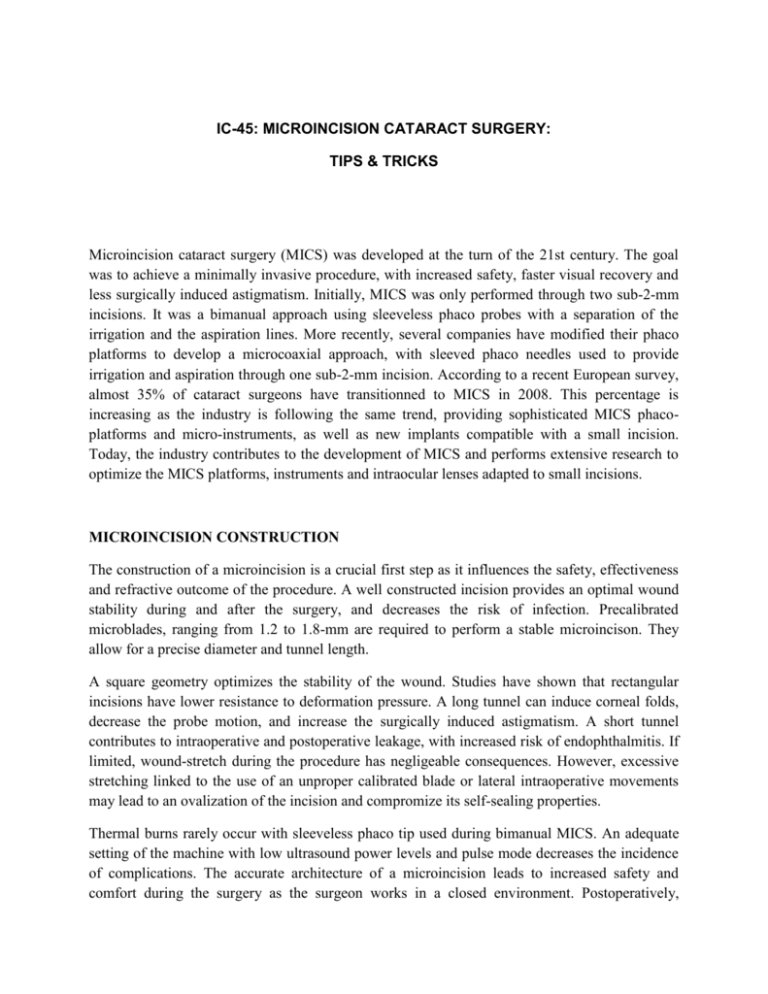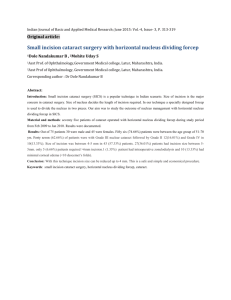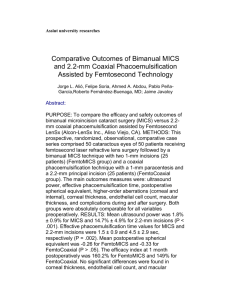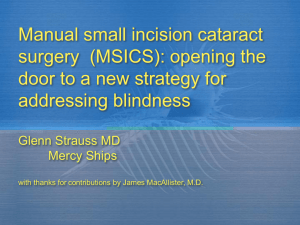IC-45_Febbraro_Handout - European Society of Cataract
advertisement

IC-45: MICROINCISION CATARACT SURGERY: TIPS & TRICKS Microincision cataract surgery (MICS) was developed at the turn of the 21st century. The goal was to achieve a minimally invasive procedure, with increased safety, faster visual recovery and less surgically induced astigmatism. Initially, MICS was only performed through two sub-2-mm incisions. It was a bimanual approach using sleeveless phaco probes with a separation of the irrigation and the aspiration lines. More recently, several companies have modified their phaco platforms to develop a microcoaxial approach, with sleeved phaco needles used to provide irrigation and aspiration through one sub-2-mm incision. According to a recent European survey, almost 35% of cataract surgeons have transitionned to MICS in 2008. This percentage is increasing as the industry is following the same trend, providing sophisticated MICS phacoplatforms and micro-instruments, as well as new implants compatible with a small incision. Today, the industry contributes to the development of MICS and performs extensive research to optimize the MICS platforms, instruments and intraocular lenses adapted to small incisions. MICROINCISION CONSTRUCTION The construction of a microincision is a crucial first step as it influences the safety, effectiveness and refractive outcome of the procedure. A well constructed incision provides an optimal wound stability during and after the surgery, and decreases the risk of infection. Precalibrated microblades, ranging from 1.2 to 1.8-mm are required to perform a stable microincison. They allow for a precise diameter and tunnel length. A square geometry optimizes the stability of the wound. Studies have shown that rectangular incisions have lower resistance to deformation pressure. A long tunnel can induce corneal folds, decrease the probe motion, and increase the surgically induced astigmatism. A short tunnel contributes to intraoperative and postoperative leakage, with increased risk of endophthalmitis. If limited, wound-stretch during the procedure has negligeable consequences. However, excessive stretching linked to the use of an unproper calibrated blade or lateral intraoperative movements may lead to an ovalization of the incision and compromize its self-sealing properties. Thermal burns rarely occur with sleeveless phaco tip used during bimanual MICS. An adequate setting of the machine with low ultrasound power levels and pulse mode decreases the incidence of complications. The accurate architecture of a microincision leads to increased safety and comfort during the surgery as the surgeon works in a closed environment. Postoperatively, several studies have shown that MICS stabilizes the optical quality of the cornea, prevents surgically induced astigmatism, avoids corneal aberrations and provides faster visual recovery. MICS INSTRUMENTS The reduction of the incision size requires a perfect calibration of the instruments used during the procedure. As mentioned in the previous paragraph, microblades are necessary to obtain an incision size slightly larger than the US and I/A probe. Trapezoidal blades with 1.6 x 1.8 mm size allows for equilibrated inflow of fluid with limited friction of the probe during the different steps of the surgery. This incision size is compatible with a wound-assisted implantation of most MICS intraocular lenses. The capsulorrhexis is easily performed either with a bent needle or microforceps specifically designed for sub-2-mm incision. Irrigating choppers or dividers with large bores positioned in the front or laterally are used to chop or divide the nucleus during bimanual MICS. Several types of vertical or horizontal choppers are available. Irrigating and aspirating probes are also designed to complete the I/A part of phacoemeuslification and facilitate the aspiration of the cortex, particularly under the incision site. PHACO PLATFORMS Today, most phaco platforms are developed to be MICS compatible. Several technical points have been adjusted to optimize the results of the phaco machine used in conjonction with microincisions. Smaller incision sizes imply the use of microphaco tip. Twenty-gauge phaco tips are currently used with all types of machines. The smaller inside diameter of the phaco tip reduces the holding power of the tip. However, special tip designs such as flared tips counteract this limitation. In addition, the restricted inner phaco tip diameter can slow down surgery speed. Thus, the use of smaller phaco tips requires higher vacuum settings to perform an effective phacoemulsification. Fluidics is regulated by peristaltic or venturi pumps but today, the latest pumps are mixed pumps, which offer the best of the two systems to equilibrate the inflow and the outflow. The goal is to obtain a stable anterior chamber all along the different steps of phacoemulsification. The inflow of fluid is mainly regulated by the height of the bottle. The inflow should always be superior to the outflow to avoid surge. Antisurge tubings and algorythms as well as anticlogging filters are currently available. These technological advances reduce the incidence of clogging and postocclusion surge and improve anterior chamber stability even with higher levels of vacuum. The modulation of ultrasounds and the lower frequency of the phaco handpiece have limited the temperature at the incision site and decreased the energy delivered into the eye. This is particularly advantageous in bimanual MICS where a sleeveless phaco probe is used. Most machines allow for customized ratios of "on-time and off-time power settings", called duty cycle, and variable power intensities to minimize the total amount of phaco energy delivered into the eye. The modulation of ultrasound with the onset of pulses and bursts has transformed phacoemulsification from an ultrasound, power driven technique to an aspiration, manual chopping driven technique. Continuous and high levels of ultrasounds which could cause thermal trauma to the incision and endothelial damage are no longer necessary. Effective fluidics control and power modulation softwares have contributed to a widespread acceptance of MICS, shortened the learning curve and improved the effectiveness and safety of the procedure. SURGICAL TECHNIQUES Microincision cataract surgery can be performed with two different techniques: bimanual (BMICS) and coaxial (C-MICS). In the B-MICS, a sleeveless phaco probe provides the US and aspiration and a separated irrigating instrument is used through a second incision. The fluidics of B-MICS are particularly advantageous for an effective phacoemulsification. The separation of aspiration and irrigation lines allows for a synergetic work of the two functions. Irrigating instruments need to provide sufficient inflow to balance high vacuum settings. The learning curve of B-MICS is steeper than for the C-MICS, and could explain why the majority of cataract surgeons perform coaxial phacoemulsification. In C-MICS, a sleeved phaco probe provides aspiration and irrigation through one incision. The only difference with a standard coaxial phaco is the reduction of the incision size which explains why there is almost no learning curve with C-MICS. The divide and conquer technique is compatible with MICS. Specific irrigating dividers are available to accomodate the scuplture of the lens. Chop or stop & chop techniques allow for a faster and more effective nucleus extraction with less intraocular energy delivered. Stop & chop facilitates the transition from divide and conquer to chop technique. The manipulation of the sleeveless phaco probe and the irrigating chopper requires particular attention to avoid incision and Descemet's membrane damage. The phaco tip is inserted with the bevel down and the chopper horizontal. They are rotated clockwise in the anterior chamber. To maintain the inflow of fluid and the anterior chamber stability, the irrigating instruments are always pulled out of the eye after the phaco probe and the aspirating tip. Power and fluidics settings vary according to the machine, technique and cataract grades. This includes the height of the bottle, vacuum, flow rate, ultrasound power and mode (duty cycle, pulse, burst) during the different steps of the procedure and for some machines, the adjustment of the pedal's dual linear control. The choice between longitunal, torsional or elliptical ultrasounds depends on the phaco machine and surgeon's preferences. These ultrasound delivery systems aim at optimizing the effectiveness of the procedure with improved followability, efficiency and safety. Hydrodissection is a crucial step in MICS as the small size of the incison limits the amplitude of the maneuvers and prohibits lateral movements during the surgery. Partial removal of viscoelastic substance is necessary before the beginning of hydrodissection to avoid an over-inflated anterior chamber. Minimal volume of fluid is injected to obtain hydrodissection and hydrodelineation. The cannula is inserted under the capsulerrhexis border, the capsule is slightly raised and the fluid is directed in the capsular bag to separate the capsule from the lens and the epinucleus from the nucleus. MICS INTRAOCULAR LENSES An increasing number of MICS IOLs are now available on the market. Hydrophilic IOLs represents the majority of lenses as they are more easily implantable through sub 2-mm incisions. Intraocular lens implantation is performed with a wound-assisted technique through a 1.6 mm incision size. Specific cartridge and syringe type injectors garantee a safe and reproducable implantation with no need for incision enlargement. Complete removal of viscoelastic substance is required at the end of the procedure to minimize the risk of IOL dislocation. MICS IOLs are by definition thinner than standard ones and their in-the-bag implantation needs to be secured and stabilized at the end of the surgery. Studies have shown that MICS IOLs provide excellent optical performances and stable refractive results. Some of the lenses have multifocal optics and can also correct astigmatism at the same time. The interest in microincision cataract surgery is constantly growing with the industry encouraging this evolution. In fact, technological improvements of the phaco platforms with optimized fluidics and power modulation control facilitates the transition and improves the safety and effectiveness of phacoemulsification. Specifically designed microinstruments enable easy maneuvers during the procedure and shorten the learning curve. The availability of high-quality MICS IOLs with reliable injecting systems completes the surgical arsenal. Over the years, there has been a consistent reduction in cataract incison size and this trend should continue in the future. REFERENCES 1. Alio JL, Rodriguez-Prats JL, Galal A, Ramzy M. Outcomes of microincision cataract surgery versus coaxial phacoemulsification. Ophthalmology. 2005;112:1997-2003 2. Alio JL, Rodriguez-Prats JL, Vianello A, Galal A. Visual outcome of microincision cataract surgery with implantation o Acri Smart Lens. J. Cataract Refract Surg 2005;31:1549-1556 3. Agarwal A, Agarwal A, Agarwal S. Phaconit: phacoemulsification through a 0.9 mm corneal incision. J. Cataract Refract Surg 2001;27:1548-1552 4. Ernest P, Neuhann T. Posterior limbal incision. J. Cataract Refract Surg 1996;22:78-84 5. Koch PS. Structural analysis of cataract incision construction. J. Cataract Refract Surg 1991;17:661-671 6. Fine IH, Hoffman RS, Packer M. Profile of clear corneal cataract incisions demonstrated by ocular coherence tomography. J. Cataract Refract Surg 2007;33:94-97 7. Braga-Mele R. Thermal effect of microburst and hyperpulse settings during sleeveless bimanual phacoemulsification with advanced power modulations. J. Cataract Refract Surg 2006;32:632-642 8. Fine IH, Packer M, Hoffman RS. Power modulations in new phacoemulsification technology: improved outcomes. J. Cataract Refract Surg 2004;30:1014-1019 9. Elkady B, Alio JL, Ortiz D, Montalban R. Corneal aberrations after microincision cataract surgery. J. Cataract Refract Surg 2008;34:40-44 10. Schimdbauer JM, Escobar-Gomez M, Apple DJ, Peng Q, Arthur S, Vargas LG. Effect of haptic angulation on posterior opacification in modern foldable lenses with a square, truncated optic edge. J. Cataract Refract Surg 2002;28:1251-1255 18. 2007;104:60-65







